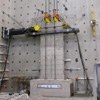Bowen Lab Projects - Earthquake Engineering
Establishing a Research Network in Hybrid Simulation for Multi-Hazard Engineering
This NSF-funded research coordination network seeks to broaden the community and forge new partnerships able to tackle the scientific challenges that lie ahead, and thus facilitate the advances needed to both establish the fundamental theory of and expand the capacity for hybrid simulation methods for natural hazards applications.
Seismic Response of Reinforced Concrete Walls with Lap Splices
Lap-splice failures in reinforced concrete walls and smoke stacks after recent earthquakes (e.g. Izmit, Turkey in 1999, Northridge, United States in 1994, Maule, Chile in 2010) and the scarcity of experimental data revealed the need for this investigation.
US-China: Verification of Real-Time Hybrid Simulation Through Shake Table Comparison
Real-time hybrid simulation (RTHS) provides researchers the opportunity to isolate and physically investigate only the more complex or critical components, while numerically including the remainder of the structure. This approach allows for a wide range of configurations to be tested using a single test specimen. This work present the results of a three phase project focusing on comparison of analytical simulation, physical full-scale tests and real-time hybrid simulation tests of a medium-scale prototype structure under various earthquake inputs.
NEES Data Flow Testbed
To support user requested developments, NEEScomm has developed a simplified testbed revolving around the typical "Data Flow" used by NEES researchers. The testbed facilitates building a partnership between IT and the earthquake engineers.
Detecting and Quantifying Damage in Buildings using Earthquake Response Data
The focus of this research is to develop the means to detect and quantify damage in buildings following earthquakes. The hypothesis is that building acceleration records contain sufficient characteristic information to develop the lateral-load resistance curve, also known as the capacity curve, from which the extent and locations of nonlinear behavior could be estimated.
University Consortium for Instructional Shake Tables (UCIST)
Experiments are quite effective for demonstrating basic concepts in structural dynamics and earthquake engineering to students. Shake tables are typically used for experimental research in earthquake engineering, but they are also very useful for instructional demonstrations.
Performance-Based Design and Real-time, Large-scale Testing to Enable Implementation of Advanced Damping Systems
Advanced structural damping systems such as magnetorheological dampers have great potential to play a large role in our ability to achieve performance-based structural design (PBD) directed towards seismic resilience. This research project focuses on the development of appropriate performance-based design procedures and model-based simulation techniques for advanced damping systems in civil engineering applications.
NEES Collaborative Research: Behavior of Spirally Reinforced Concrete Columns under Load Reversals
This project is part of a collaborative study of Soil-Foundation-Structure-Interaction (SFSI). To study the prototype structure, a series of four physical models were tested in the overall project. These models were tested using one of the following test types: centrifuge testing,field tests, shaking table tests, and laboratory tests. Large-scale individual columns and bridge bents have been built and tested at Purdue to evaluate strength degradation in flexure and shear under cyclic loads.
CyberMech, a Novel Run-Time Substrate for Cyber-Mechanical Systems
The core objective of this collaborative research is to develop a novel run-time substrate, CyberMech, to enhance the performance of real-time cyber-mechanical experiments through an integrated set of advances.
Viewing 1 to 9 of 9








